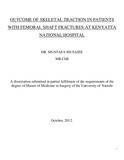| dc.contributor.author | Musajee, Mustafa | |
| dc.date.accessioned | 2013-09-13T13:18:56Z | |
| dc.date.available | 2013-09-13T13:18:56Z | |
| dc.date.issued | 2013 | |
| dc.identifier.citation | Master of Medicine in Surgery | en |
| dc.identifier.uri | http://erepository.uonbi.ac.ke:8080/xmlui/handle/11295/56490 | |
| dc.description.abstract | Background: -
Road traffic accidents are a leading cause of trauma in Kenya (1). Many of the victims have multiple injuries with a significant proportion having femoral fractures (2).
While early fracture fixation is advocated to ease pressure on costs and morbidity associated with prolonged hospitalization, this is not possible for all patients who present at KNH due to a variety of factors. Majority have to be on prolonged periods of skeletal traction as they await internal fixation while in others, it is the definitive treatment.
While the spectrum of complications associated with skeletal traction is known, there are no studies to show the burden of these complications at KNH and hence justify continued use of skeletal traction for patients awaiting surgery.
Objective :
To determine the incidence of complications associated with skeletal traction in patients with femoral shaft fractures at KNH and analyse their occurrence in relation to the duration of traction.
Study Design and Setting:-
This was a prospective, descriptive study of convenience sampling method of patients admitted with femoral shaft fractures during a 3-month period in the orthopaedic wards at KNH.
Patients and methods:
Consecutive adult patients admitted with femoral shaft fractures of either sex on skeletal traction for more than two days as they awaited internal fixation were recruited.
Data collected included the patient demographics, duration of skeletal traction, other associated injuries, cause of the fracture, fracture geometry and occurrence and time of onset of complications directly related to skeletal traction. The outcome measurewas the occurrence of one or more complications associated with skeletal traction. Significant variables measured included PTI; knee stiffness; quadriceps muscle atrophy and pneumonia.
Results:
Seventy five patients with femoral shaft fractures on skeletal traction were recruited. Transverse and comminuted fracture patterns were the most common accounting for 41.3% and 37.3% of the fractures
respectively. Ninety six percent of the patients were managed on Perkins mode of traction, whilst the mean duration on traction was 4.7 weeks. Prevalence of PTI was 24% occurring most commonly during the 5th and 6th week on traction, PTI was significantly associated with comminuted fractures with 42.9% of the patients with this fracture pattern developing PTI. Knee stiffness was the most common complication and 62.7% of the study population had stiffness by the 4th week on traction. Only 36% of the patients got reduction in their thigh circumference from the time of onset of traction.
PTI was significantly associated with prolonged durations of traction as patients who developed PTI were on traction for average of 6.7 weeks as compared to 4.25 weeks for those who did not develop any PTI. Patients who were on traction for an average of 2.7 weeks were at a lower risk of developing knee stiffness as compared to those on traction for 5.6 weeks.
Conclusion:
Knee stiffness and pin tract infection were the most common complications associated with skeletal traction with the latter associated more with comminuted fractures. The incidence of these two rose significantly from the fourth week of traction. | en |
| dc.language.iso | en | en |
| dc.publisher | University of Nairobi | en |
| dc.title | Outcome of skeletal traction in patients with femoral shaft fractures at Kenyatta National Hospital | en |
| dc.type | Thesis | en |
| dc.description.department | a
Department of Psychiatry, University of Nairobi, ; bDepartment of Mental Health, School of Medicine,
Moi University, Eldoret, Kenya | |
| local.publisher | Department of Medicine | en |

